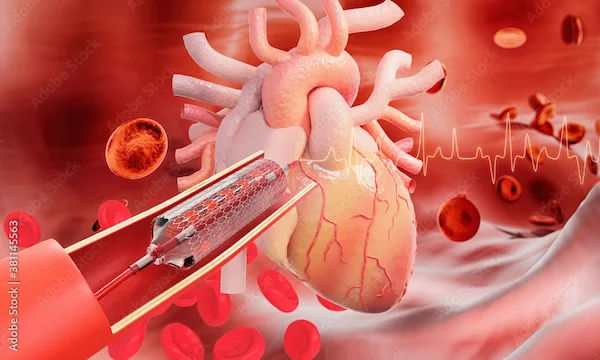Describe Nursing Care Of The Post Angioplasty Patient
Understand the essential nursing care for post-angioplasty patients, including vital sign monitoring, pain management, wound care, medication administration, and patient education for a smooth recovery.

Written by
Last updated on 7th Jul, 2025

Introduction
Undergoing angioplasty can be a lifechanging procedure, especially for those dealing with blocked arteries. While the surgery helps restore blood flow to the heart, proper postoperative care is crucial for a smooth recovery. If you or a loved one has recently had angioplasty, understanding the necessary nursing care can help ensure a faster and safer healing process.
What Is Angioplasty?
Angioplasty is a minimally invasive procedure where a small balloon is used to widen a narrowed or blocked artery. Often, a stent (a tiny mesh tube) is placed to keep the artery open, improving blood flow to the heart. While the procedure is effective, recovery requires careful monitoring and lifestyle adjustments.
Immediate Post-Angioplasty Nursing Care
After angioplasty, patients are moved to a recovery area where nurses closely monitor vital signs, including:
Heart rate and blood pressure – To detect any irregularities.
Oxygen levels – Ensuring proper oxygen supply to the heart.
Bleeding or swelling at the catheter insertion site – Usually in the groin or wrist.
Key Nursing Interventions
Key nursing intervention are:
1. Monitoring for Complications
Nurses check for signs of bleeding, infection, or blood clots.
Chest pain or discomfort should be reported immediately.
2. Pain Management
Mild discomfort at the insertion site is normal, but severe pain may indicate complications.
3. Encouraging Rest
Patients must lie flat for a few hours to prevent bleeding.
Consult Top Cardiologists For More Information
Post-Discharge Care at Home
Once discharged, patients must follow specific care guidelines to prevent complications and ensure long-term heart health.
1. Wound Care
Keep the insertion site clean and dry.
Watch for redness, swelling, or discharge, which may indicate infection.
2. Medication Adherence
Blood thinners (like aspirin or clopidogrel) – Prevent blood clots around the stent.
Cholesterol-lowering drugs (statins) – Keep arteries clear.
Blood pressure medications – Maintain healthy circulation.
Never stop medications without consulting your doctor.
3. Activity Restrictions
Avoid heavy lifting or strenuous activities for at least a week.
Gradually increase walking to improve circulation.
4. Diet and Lifestyle Changes
Heart healthy diet: More fruits, vegetables, whole grains, and lean proteins.
Reduce salt, sugar, and unhealthy fats – Helps control cholesterol and blood pressure.
Quit smoking – Smoking increases the risk of artery renarrowing.
Limit alcohol – Excessive drinking can interfere with medications.
5. Follow-Up Appointments
Regular checkups ensure the stent is functioning well.
Cardiac rehabilitation programs may be recommended for supervised exercise and education.
Warning Signs to Watch For
Seek immediate medical help if you experience:
Severe chest pain or pressure (may indicate a heart attack).
Excessive bleeding or swelling at the insertion site.
Shortness of breath, dizziness, or fainting.
Fever or signs of infection.
How Apollo 24|7 Can Help?
Recovering from angioplasty requires expert guidance. Apollo 24|7 offers:
Cardiac consultations – Speak with specialists for personalized advice.
Home care services – Nursing assistance for wound care and monitoring.
Diet and rehabilitation programs – Tailored plans for heart health.
You can easily book a followup consultation or diagnostic tests through the Apollo 24|7 app or website.
Final Thoughts
Postangioplasty care plays a vital role in long-term recovery. By following medical advice, taking prescribed medications, and adopting a heart healthy lifestyle, patients can significantly reduce the risk of future complications. Remember, your heart deserves the best care—stay informed, stay proactive, and don’t hesitate to seek professional help when needed.
If you have any concerns about your recovery, consult a cardiologist today for expert guidance.
Consult Top Cardiologists
Consult Top Cardiologists For More Information

Dr. Bhukya Pavan Kalyan
General Physician
5 Years • MBBS DNB Paediatrics
Bengaluru
PRESTIGE SHANTHINIKETAN - SOCIETY CLINIC, Bengaluru

Dr. Tripti Deb
Cardiologist
40 Years • MBBS, MD, DM, FACC, FESC
Hyderabad
Apollo Hospitals Jubilee Hills, Hyderabad
Dr Moytree Baruah
Cardiologist
10 Years • MBBS, PGDCC
Guwahati
Apollo Clinic Guwahati, Assam, Guwahati

Dr. Zulkarnain
General Physician
2 Years • MBBS, PGDM, FFM
Bengaluru
PRESTIGE SHANTHINIKETAN - SOCIETY CLINIC, Bengaluru

Dr. Janjirala Seshivardhan
Cardiologist
7 Years • MBBS,DNB(GM),DM(Cardiology)
Manikonda Jagir
Apollo Clinic, Manikonda, Manikonda Jagir
Consult Top Cardiologists

Dr. Bhukya Pavan Kalyan
General Physician
5 Years • MBBS DNB Paediatrics
Bengaluru
PRESTIGE SHANTHINIKETAN - SOCIETY CLINIC, Bengaluru

Dr. Tripti Deb
Cardiologist
40 Years • MBBS, MD, DM, FACC, FESC
Hyderabad
Apollo Hospitals Jubilee Hills, Hyderabad
Dr Moytree Baruah
Cardiologist
10 Years • MBBS, PGDCC
Guwahati
Apollo Clinic Guwahati, Assam, Guwahati

Dr. Zulkarnain
General Physician
2 Years • MBBS, PGDM, FFM
Bengaluru
PRESTIGE SHANTHINIKETAN - SOCIETY CLINIC, Bengaluru

Dr. Janjirala Seshivardhan
Cardiologist
7 Years • MBBS,DNB(GM),DM(Cardiology)
Manikonda Jagir
Apollo Clinic, Manikonda, Manikonda Jagir




